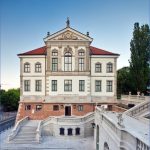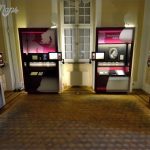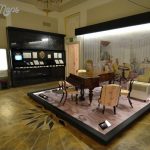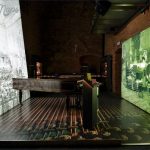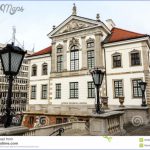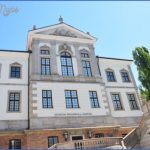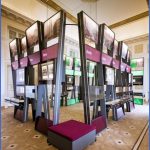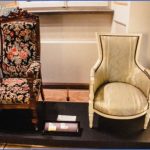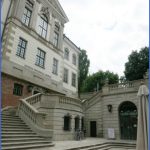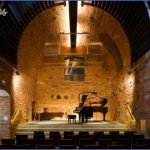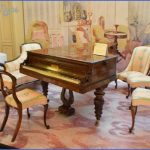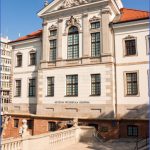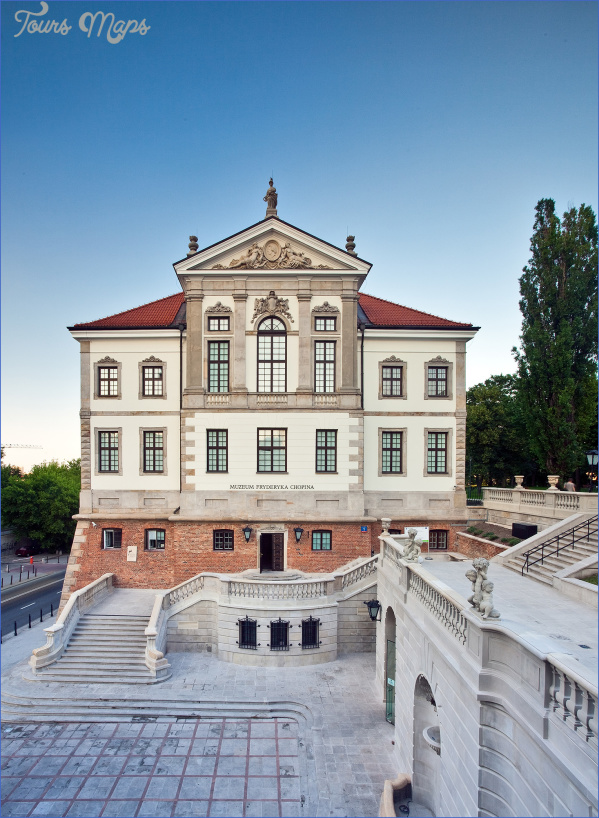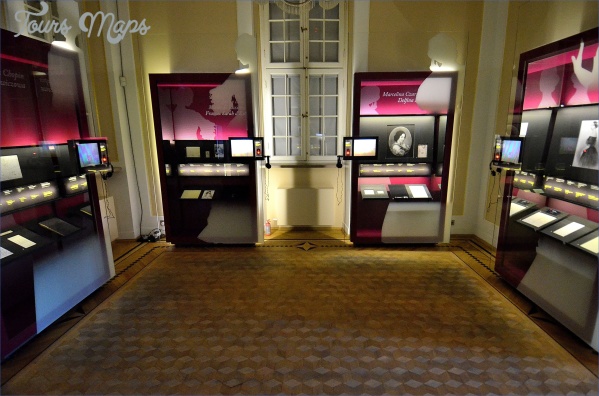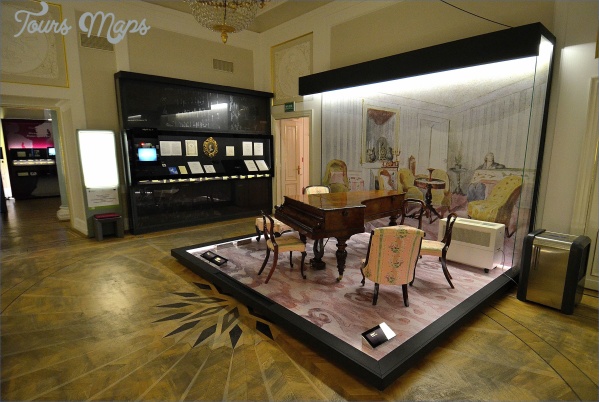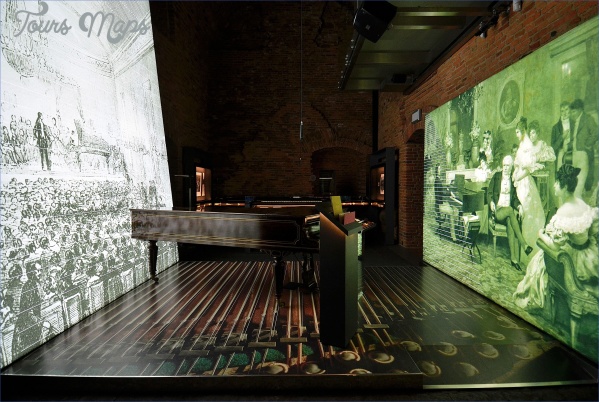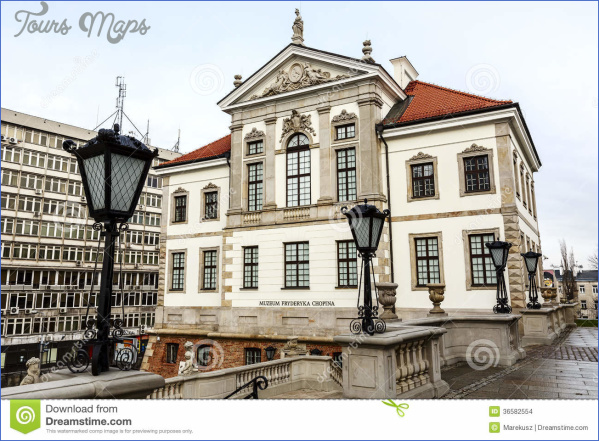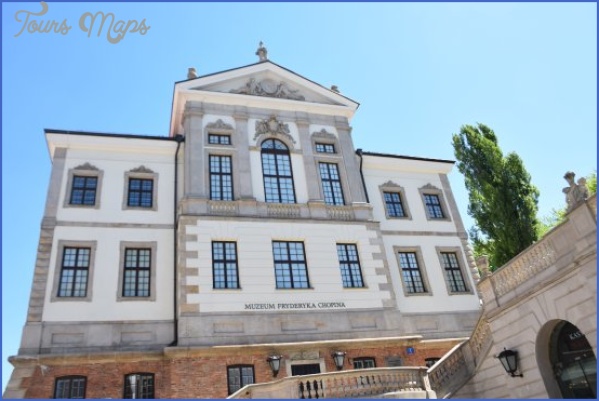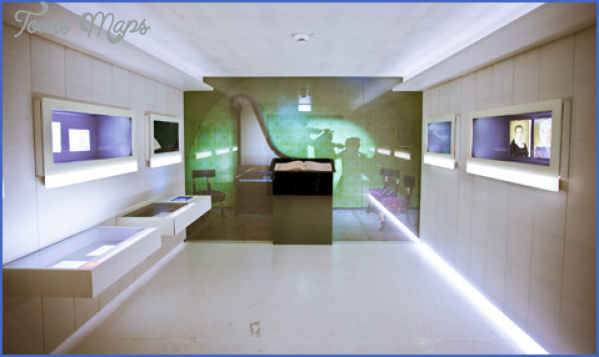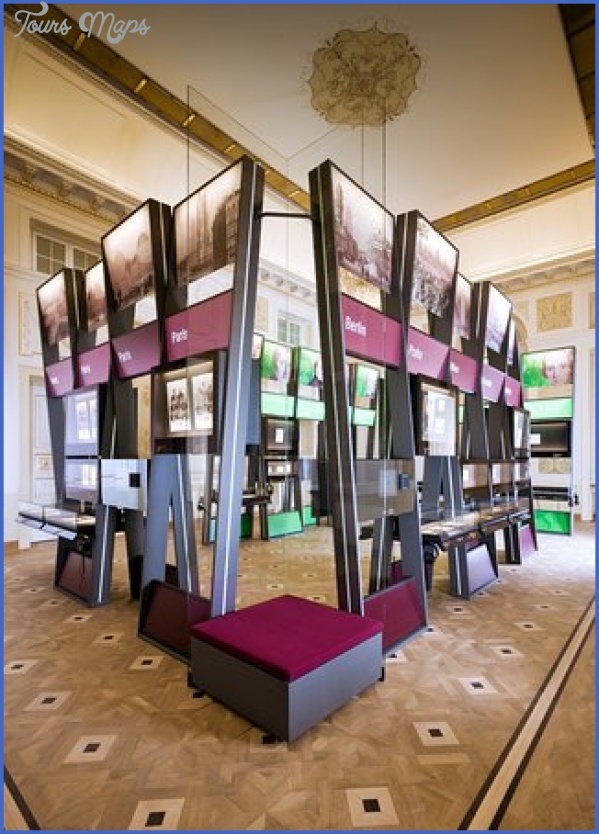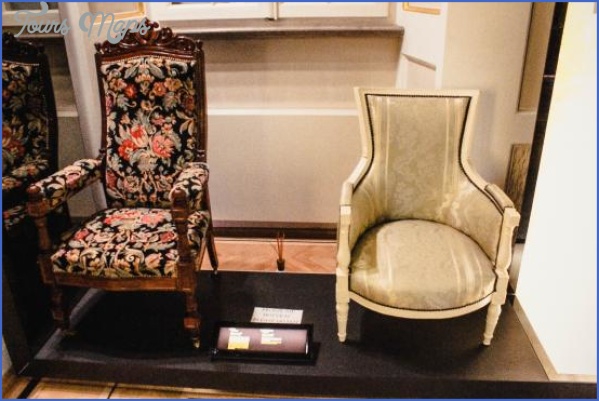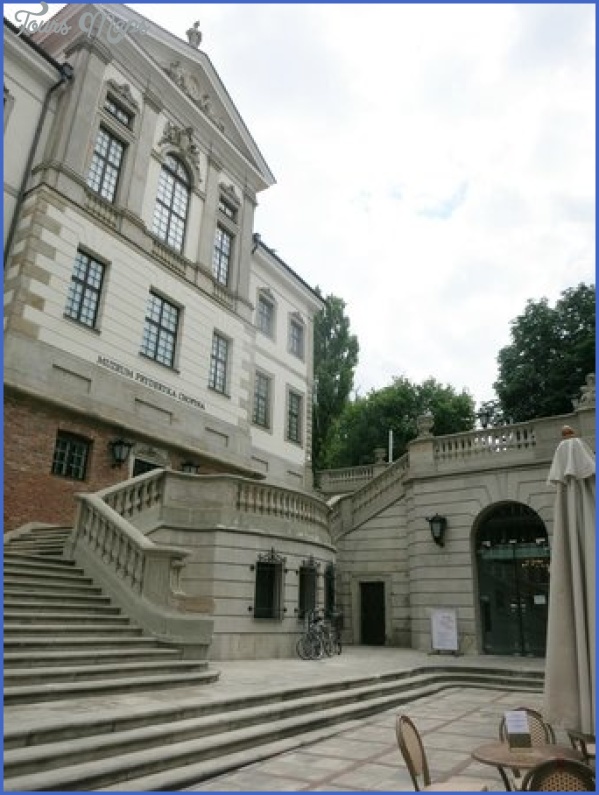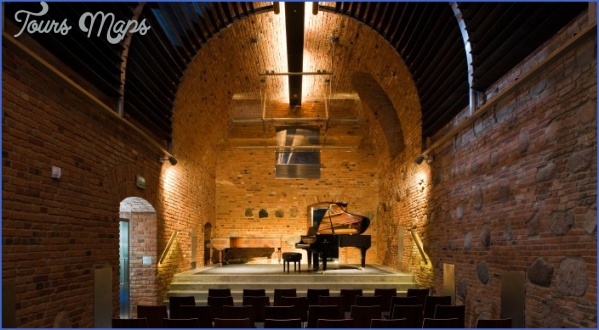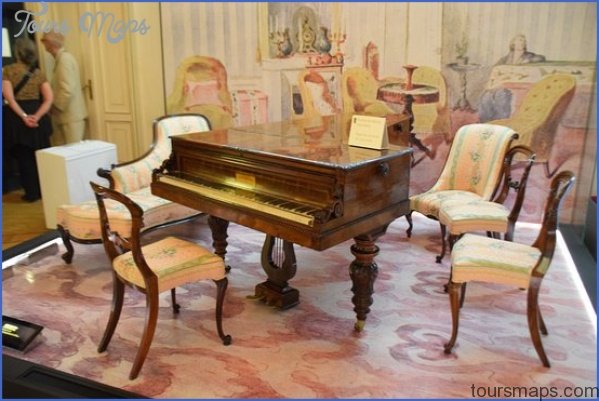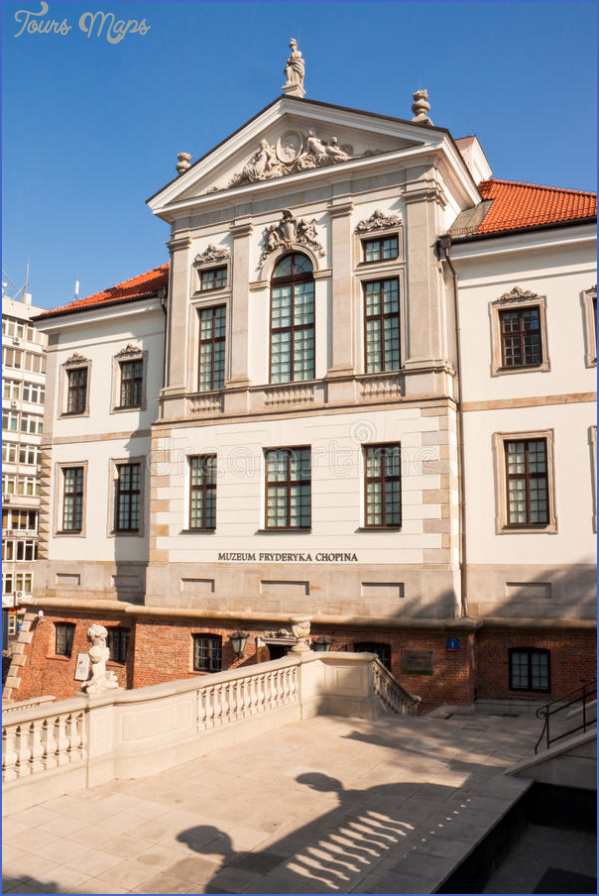CHOPIN MUSEUM
As one of the most Romantic and most appealing of composers, Fryderyk Chopin is widely commemorated – most of all, of course, in his native Poland, but also in the Czech Republic and Spain and to a modest extent elsewhere. The most important collection of Chopiniana is, appropriately enough, in Warsaw, at the museum of the Frederic Chopin Society. But for lovers of his music there are other shrines: his birthplace at Zelazowa Wola, the Holy Cross Church in Warsaw where his heart is interred in a pillar, the Carthusian monastery at Valldemossa on the Mediterranean island of Majorca where he spent the winter of 1838-9 with George Sand, and his tomb – perpetually flower-strewn – in the Paris cemetery of Pere Lachaise.
Chopin left Poland when he was 20, and he never returned. His compatriots understandably make the most of his few Polish years. It seems that his memory is nurtured at almost every place he visited: at Brochow (where he was christened), Duszniki Zdroj, Poznan, Sanniki, Sulechow, Szafarnia and Antonm, and the Krasinski Palace in Warsaw, at all of which he spent a holiday period or played or both. Chopin memorial rooms, societies, centres, concert halls, festivals and piano competitions commemorate the connections.
Abroad too: in the Bohemian spa Marianske Lazne (Marienbad), which he visited, in the Carthusian monastery at Valledemossa where he passed several chilly weeks with George Sand, and in France at La Chatre (seven kilometres from Sand’s house at Nohant) where he spent seven summers. Elsewhere plaques mark some of the places – for example in Paris, London and Vienna – where he once stayed. But Paris lacks the museum that his long residence (from 1831, in effect) and his death there (in 1849) would surely justify, and the Nohant commemoration too is modest.
In the Mazovian countryside, some 45 km west of the capital, close to the main road that leads to todz and to Poznan, is /Zelazowa Wola, then the estate of Count Fryderyk Skarbek, Chopin’s godfather. There, on 22 February or 1 March 1810 (sources differ), Chopin was born. His father, a Frenchman, was tutor to the count’s children, and his mother had a family connection with the Skarbeks. Most of the estate, which was sold in the 1850s, was destroyed in a fire later in the century, but the cottage (or dwor) survived, the only building to do so. The earliest thoughts of turning it into a Chopin memorial came from the Towianskis, the family who bought the estate from the Skarbeks, but nothing was done under successive owners until 1891, with an initiative by the Russian composer Mily Balakirev with the Warsaw Music Society. An obelisk commemorating Chopin was erected there and dedicated, with an appropriate musical ceremony, in 1894. It was only in 1931 that a committee, including Ignacy Paderewski, arranged to take over the ownership of the cottage and to have it restored as a museum with a recital room. The surrounding land was attractively landscaped as a park and in 1939 the house was opened to the public. During World War II it suffered damage but it was restored and reopened in 1949, the centenary of Chopin’s death, under state ownership but from 1953 in the care of the Frederic Chopin Society. That restoration was limited in scope but efforts were made in the ensuing years to Rights were not granted to include these illustrations in electronic media. Please refer to print publication Chopin’s birthplace, Zelazowa Wola enlarge the displays and improve the decor, culminating in a more historical restoration in 1968; at that time, too, the 1894 monument, which had been moved to a side of the park, was replaced by a stone bust by Stanislaw Sikora and a bronze monument by Jozef Goslawski. The cottage opens to a courtyard, surrounded by chestnut trees; to the south are vines in a trellis arbour which had originally linked the cottage with the estate house. The cottage itself has a high sloped roof with mansard windows, which like the wooden entrance porch were a later addition. The interior however still follows the original layout. There is a brick-floored hallway through the centre, with three rooms on each side. To the right is a room with a fireplace, presumed to have been the kitchen, now equipped with suitable Polish furniture and kitchenware of Chopin’s time, including a tiled stove. Next is the drawing-room, with furniture believed to have adorned the Skarbek house, as well as several portraits, including copies of those of Chopin by Maria Wodzinska and Eliza Radziwill, and a modern concert grand piano: this room is used for recitals, which are relayed to the audience on the terrace outside and in the park beyond. The third room on the right is the dining-room, with Biedermeier-style furniture, china and porcelain and engravings after Canaletto of 18th-century Warsaw. To the left of the central corridor are what were presumably the family’s private rooms: first, the mother’s, the largest, with a 19th-century piano, a fine wall clock in ivory and bronze (thought to have belonged to the Skarbeks), an 18th-century desk with musical decorations, more Biedermeier furniture, portraits including copies of lost originals of Chopin, his sisters and his parents, and facsimiles of marriage and birth certificates – and there is an alcove supposed to be the actual spot where Chopin was born; second, a children’s room, re-created; and third, his father’s room, soberly furnished but with historical etchings and a facsimile of Chopin’s own drawing of a village land- scape. On the upper floor are rooms for visiting recitalists.
CHOPIN MUSEUM Photo Gallery
In the summers of 1824 and 1825, when he was 14 and 15, Chopin was invited by a fellow pupil at the Lyceum in Warsaw, Dominik Dziewanowski, to spend some time with him and his family at their country house in Szafarnia, about 150 km north-west of Warsaw, not far from Torun. His memory is preserved in this attractive lakeside mansion, now a Chopin Centre, in a Chopin competition held each May and in a small Chopin museum. There is a pleasant, light recital room, seating about 80, with a bust of Chopin (there is another by the front entrance) and a fairly comprehensive set of Chopin portraits, in good reproductions, around the walls, along with posters. Probably this is the room where Chopin played at the Dziewanowski family soirees. Next to it is a spacious and elegant octagonal exhibition room, which one may survey to a background of piano music and Polish commentary (chiefly about current events at Szafarnia). A prize exhibit is a group of copies from the Kurier Szafarski, a homemade newspaper edited by Chopin and produced by him and his friends when he was there. There is a plaster cast of Chopin’s left hand and many reproductions of pictures connected with his life and his death, the women in his life, his teachers, his family and some letters, and also a copy of a landscape drawn by Chopin himself. Much of the material is concerned with the musical events held at Szafarnia, which include, along with the competition, regular recitals and occasional symposia.
Of the Chopin sites outside Warsaw, none is more remarkable than Prince Antoni Radziwill’s former hunting lodge at Antonm, some 275 km west and slightly south of Warsaw (about 20 km south of Ostrow Wielkopolski). A three-storey, wooden folly set in parkland, it is now a youth hostel, cafe and memorial rooms, with accommodation in the four wings extending out from the central octagonal body of the building. Built early in the 19th century to a design believed to be by
The former Radziwi 11 hunting lodge at Antonin
Karl Friedrich Schinkel (as centre of a complex including a shepherd’s house with a milk-drinking salon, a forester’s lodge, stables and a small chapel, where family members are buried), it was presumably just as astonishing in its day as it is now, with its galleries overlooking the octagon, its huge central column of fireplaces and its dramatic wood ceiling. It provided a unique setting for Chopin’s performances on his visits in 1827 and 1829. For the prince, an amateur cellist, he composed the op.3 Polonaise for piano and cello and the Piano Trio op.8, in which they were joined in performance by the prince’s violinist daughter. Off the octagon, on the ground floor, are two rooms devoted to Chopin, containing two pianos, furniture and reproductions of portraits and music. A modern concert grand resides in the octagon room, where chamber recitals are held: each September there is a Chopin festival and every other year since 1988 there have been seminars for young Chopin scholars, ‘Vacations with Chopin’.
About 25 km west of Zelazowa Wola, not far from Plock, lies Sanniki, where the family of another of Chopin’s school friends, Konstanty Pruszak, had an estate. Chopin accepted an invitation to spend a holiday there in the summer of 1828; while he was there he wrote the Rondo for two pianos op.73. The country house in which he stayed later burnt down and was replaced in 1910 by a much more palatial building, opposite the village church. This is now largely given over to local government offices, a public library and a nursery school, but since 1981 one wing has housed a Frederic Chopin Centre. In the concert room, which holds 120 people, there are monthly Sunday afternoon recitals, with recitations of Polish poetry, between February and October. On the upper floor is the library that once belonged to the Chopin scholar Mateusz Glinski (1892-1976), supplemented since his time, and a reading room. In the foyer of the hall and the hall itself Chopin materials, from the Frederic Chopin Society in Warsaw, are displayed, among them reproductions of Chopin portraits and manuscripts, contemporary illustrations of Warsaw and porcelain of the period. In front of the building is a bronze statue by Ludwika Kraskowska-Nitschowa, unveiled in 1985 on the 175th anniversary of the composer’s birth, and there is a plaque commemorating Chopin’s connection with Sanniki, dating from 1925.
Later in 1828 Chopin visited Berlin, and on the way home paused in Poznan where he played at receptions given by the Archbishop and Prince Antoni
Radziwill. His visit is commemorated in a Chopin Room in the Poznan Museum of Musical Instruments, with a small but fine collection. It includes a piano from Antonm, a late 18th-century instrument, which Chopin might have played; a bust, a model for the monument in Warsaw; several portraits, including a drawing by Teofil Kwiatowski of Chopin at the time of his death and a pastel by him of a ball, showing Chopin with various people who played roles in his life, as well as a lithograph by Henryk Siemiradzki of Chopin playing at a concert at Antonm; and a death mask and a cast of Chopin’s hand.
During his years at the conservatory in Warsaw, Chopin was evidently in love with a fellow pupil, Konstancja Gladkowska, a singing student, and his feelings seem to have been reciprocated to some extent, although Konstancja later expressed surprise at the strength of feeling for her that he showed in letters to others. He went away, and she married a nobleman. Blind from the age of 36, she was widowed in 1879 and moved to the town of Skierniewice, near her husband’s estates, about 75 km south-west of Warsaw. In 1987 her house, behind St Jakub’s Church just off the town square, was turned into a museum to Chopin and Konstancja. There are copies of their letters – hers to him, his to others – that record their love, but no original material; the rooms however are fitted out with furniture of the mid-19th century. There is a recital room, seating 40, where concerts are held regularly, with special events on the birth and death anniversaries of Chopin and Konstancja.
Warsaw itself retains many associations with the composer. The Saski Palace, where the Chopin family lived in quarters provided for the Lyceum faculty for the first six years, no longer exists, though the Saski Gardens do. When in 1817 the Lyceum moved to new quarters, the Chopins were allotted rooms in the right annexe of the Kazimierzowski Palace (now part of the Warsaw University campus); a profile relief of Chopin and a memorial plaque mark the building. The Krasinski Palace, where the family occupied a spacious third-floor flat from mid-1827, was rebuilt after its destruction in 1944 and the drawingroom was faithfully re-created from drawings (by Antoni Kolber). In the original flat the young Chopin had a study upstairs in the garret, where he had a piano and a desk. The drawing-room was the scene of his parents’ frequent soirees and it was there, on 7 February 1830, that Chopin first performed his F minor Concerto. And it was from there that he set off for Paris on 2 November of that year, never to return to Poland. Today the palace, at Krakowskie Przedmiescie 5, is occupied by the Fine Arts Academy, through which one must thread one’s way to reach the drawing-room at the front of the building. The drawing-room was opened to the public in 1960, on the 150th anniversary of the composer’s birth, and, in addition to period furniture, it displays three pianos (an Erard that once belonged to Liszt, a Buchholtz grand and a Pleyel upright; Chopin’s own piano was destroyed, apparently, when Russian soldiers threw it out of the window), two caricatures drawn by Chopin and a clock set at 18.03, said to be the time of his birth.
In 1927 – the year in which the Chopin International Piano Competition was founded – the City of Warsaw erected a monument, sculpted by Waclaw Szymanowski, just inside the main gate of the tazienki Park (the wooden model is in the collection at Poznan). In 1949 plans were set in motion to restore the 16th-century Ostrogski Castle, which between the wars had housed the Warsaw Conservatory, and establish a museum. Five years later the Frederic Chopin Society Museum opened, with Chopin displays on the ground floor, dedicated to his youth in Poland, and the second floor, covering his mature period abroad; the second floor also houses a recital hall, a library and, since 1984, an evocation of the study of the prominent pianist and teacher Jerzy Zurawlew (d 1980). The collection includes a large number of Chopin’s autographs, including the early
Rights were not granted to include these illustrations in electronic media.
Display at the Ostrogski Castle, Warsaw
F minor Polonaise, op.71, several of the op.10 Etudes, the op.65 Cello Sonata and the last F minor Mazurka, op. 68. The many original portraits include pencil drawings by Princess Eliza Radziwill and an oil by Ambrozy Mieroszewski, both from 1829, and a watercolour painted in
1836 at Marianske Lazne by Maria Wodzinska, as well as a copy of the joint portrait of Chopin and George Sand by Eugene Delacroix – the separated likenesses here reunited – which was originally painted in Paris in 1838, an 1848 oil by Antoni Kolberg, and a series of final portraits by Teofil Kwiatkowski. There is Chopin’s last Pleyel piano; unique memorabilia including his childhood drawings; letters; early editions and programmes; and other personal documents, among them his birth and baptismal certificates and his passport. There are three other Polish towns where Chopin is commemorated. About seven kilometres north-west of Zelazowa Wola is Brochow; his parents were married there at the church of St Roch, in 1806, and four years later he was baptized there. Brochow honours his memory with a Frederic Chopin Music Didactic Centre. In 1826 Chopin visited the spa of Duszniki Zdroj, not far from Wroclaw in south-west Poland, and gave two recitals; an International Chopin Festival is now held there each August, in the building (the Spa Park or Manor) in which he played. Nearby is an obelisk bearing a portrait and a bas-relief of Chopin, put up in 1897, and a more recent monument. On his way home from Berlin in 1828, according to one of his early biog- raphers, Chopin stopped briefly at Sulechow, a village near Zielona Gora: stretching his legs, he came across a piano in an inn, and began playing – and the villagers gathered to hear what became a full-scale recital. Sulechow commemorates this event with an annual competition for young pianists, held each May. One of Chopin’s early and most important teachers, Jozef Elsner, has been commemorated in the house of his birth in Grodkow, south of Wroclaw in Silesia, but the museum is closed pending refurbishment.
Chopin’s first stopping place when he left home in 1830 was Vienna, where he lived in the centre of the city until July 1831 before continuing his journey. The building at Kohlmarkt 9 where he stayed was demolished at the beginning of the 20th century but the present building commemorates his stay with a portrait relief and plaque. He also passed through Salzburg, where he visited the Mozart house.
In Paris Chopin lived at eight different addresses between 1831 and 1849, many of which are marked by memorial plaques. The longest period was in the Square d’Orleans (1842-9), in the ninth arrondissement, but he died on 12 October 1849 at 12 Place Vendome, in the first, where he had moved scarcely a month before; the house no longer stands, but a plaque marks the site. Chopin’s funeral, at which the Mozart Requiem was performed, was in the nearby Madeleine, with burial at Pere Lachaise.
Although Chopin never returned to Poland, he spent a month with his parents in Karlovy Vary (Karlsbad), in Bohemia, in 1835. On the return journey he visited Dresden, where he met the Wodzinski family, whose sons had lodged with the Chopins in Warsaw, and was greatly taken with the sister, Maria, who played the piano, sang and composed. The following summer he took up an invitation from the Wodzinskis to join them on holiday in Marianske Lazne. They took rooms in an 18th-century inn, the White Swan (the Wodzinskis stayed on the first floor, Chopin was on the second); Chopin composed and Maria painted him in watercolours. After three weeks Chopin accompanied Maria and her mother to Dresden and, on his last night there, he proposed marriage: she consented but her parents’ permission proved impossible to secure. Her letters, found among his possessions after his death, now belong to the Frederic Chopin Society in Warsaw. The White Swan, known now as the Chopin House, still stands on the main street of Marianske Lazne; the building is municipally owned but on permanent loan to the Czech Chopin Society. The room in which Chopin is thought to have stayed is filled with displays prepared by the society, documenting his Czech connections and including Czech porcelain and glassware as well as a little-known oil portrait by an unknown painter. Since 1960 an International Chopin Festival has been held there every August, and there are also piano competitions. Two months later, in November 1836, Chopin met the writer George Sand (Amantine Aurore Lucile Dupin Dudevant, who from 1832 published under the male nom de plume) in Paris at the salon of Franz Liszt and Marie d’Agoult at the Hotel de France. Their friendship, which by June 1838 had turned to love, lasted nine years. (Delacroix painted them that summer, at the height of their mutual passion; it is sadly appropriate that he left the portrait unfinished and that it was subsequently cut in two, Chopin going to the Louvre, Sand to the Ordrupgaard Samlingen in Copenhagen.) She gave up her penchant for dressing as a man for his sake. Legally separated from her husband, Baron Casimir Dudevant, with children and another lover living at her country residence in Nohant, she had ample reason to wish to go abroad, though Chopin’s deteriorating health provided in itself ample pretext for persuading him to go south with her for the winter of 1838-9. Palma, on the Spanish island of Majorca, was their destination. When they arrived on 11 November they had to seek accommodation and the villa they eventually found, ‘So’n Vent’ in the suburb of Establiments, which by local custom was rented without doors and windows, proved uninhabitable. In truth, this unconventional menagerie of foreigners was unwelcome and, when Chopin’s health took a further downward turn and news got out that he might have an infectious disease, they were compelled to decamp to a more isolated spot. The disused and relatively inaccessible Carthusian monastery on the slope of a mountain at Valldemossa, 18 km north of Palma, with views of the Mediterranean, seemed to offer the best option.
On 15 December Chopin and George Sand – with her children, Maurice (15) and Solange (10), and a maid in tow -travelled there by coach as far as they could, then clambered up the stony track to the town. They settled in three south-facing monks’ cells, with gardens overlooking the hillside orchards of oranges, olives and almonds, and the valley below. They had to provide doors and windows, their own furniture and a stove to heat the rooms during what was an exceptionally harsh winter. They had to do their own shopping and cooking, even acquiring a goat and a sheep for milk, as well as the basic housework. The Pleyel piano they had arranged to be sent was delayed in customs and arrived only in mid-January. In defiance of his illness, Chopin composed a ballade, a polonaise, a scherzo and the ‘Palma Mazurka’, and worked on the op.37 Nocturnes and the B flat minor Sonata. And although George Sand, now more nurse than lover, tutored and amused her children by day, she wrote by night, completing a novel, Spiridion, and compiling materials for a memoir of their stay, Un hiver a Majorque (1841), in which she referred to Chopin as ‘our invalid’ and ‘one of us’. But they paid dearly for their would-be idyll in Spain: when they left, on 13 February 1839, Chopin was almost too ill to make the return journey, their funds were seriously depleted and their relationship had changed for ever.
The monastery at Valldemossa, today one of the major tourist attractions of Majorca, is at the end of the main street, which is lined with souvenir shops. Within the monastery one can visit the church, the municipal museum, a recreation of an 18th-century pharmacy and a prioral cell as well as Cells 2 and 4, each of three rooms, which commemorate the two months Chopin and Sand stayed there. The whitewashed rooms still retain their elegantly arched ceilings if not their fretted rose-windows. To some extent their memories are merged in the displays. Cell 2 is partly furnished; there are reproductions of the Delacroix portraits, with watercolours by Sand here and photographs of modern Chopin interpreters there; wall niches where a death mask, a cast of his left hand and copies of letters and pen-and-ink drawings by Kwiatkowski are displayed; a manuscript copy of Un hiver a Majorque and letters in Sand’s hand; the small Majorcan piano with which Chopin made do until his Pleyel arrived, and a concert grand occasionally used for recitals. The main room of Cell 4 – ‘Celda Chopin’ – is more formal and very much a memorial. The Pleyel piano he left behind takes pride of place, its certificate of authenticity on view. There is a bust of the composer on a plinth, photocopies framed with dried roses; in an alcove to the side is a bed. In a second room there are displays of original documents (in desperate need of conservation) – among them letters, accounts and floor-plans -as well as facsimiles, including Chopin’s letter (dated Palma, 3 December 1838) to his Paris publisher, Julien Fontana, in which he admitted to being ‘malade comme un chien’.
Chopin and Sand were away from Paris for nearly a year, returning only in October 1839, after spending the summer recuperating at her country house at Nohant in Berry. In Paris they rented separate flats in the ninth arrondissement (his at 5 Rue Tronchet, hers at 16 Rue Pigalle, in fact straddling two houses), though in the autumn of 1841 he abandoned his for quarters at
Rights were not granted to include these illustrations in electronic media.
The monastery cells at Valldemossa hers. In 1842 they moved to the same building but different flats in the Square d’Orleans: Sand took a suite on the second floor, he took bachelor quarters (a salon and a bedroom) on the ground floor. Although Sand may have envisaged regular seasonal migrations between Paris and Nohant, it never quite worked that way. He loved the city while she preferred the countryside: during the summers they spent at Nohant he was often in Paris and he missed out summer 1840 altogether. Nevertheless, Nohant provided much-needed stability and contentment even for Chopin, who -between picnics, country walks, alfresco meals and amateur theatrics – composed many of his finest works there. If no longer lovers, Sand and her ‘petit Chop’ remained deeply dependent on one another. She drew his portrait and he entertained her guests. He was one of her family and yet he wasn’t; the tensions of their life together served as a continuing source of inspiration for her novels. When in 1847 the tensions could no longer be borne, they parted, meeting briefly by chance only once, on 4 March 1848. Six weeks later Chopin was in London, at the invitation of his pupil, Jane Stirling, who hoped to take Sand’s place in his life. Plaques commemorate the sites of his first performance – on 23 June at the elegant home of the singer Mrs Adelaide Sartoris, at 99 Eaton Place, SW1 – and the house at 4 St James’s Place, SW1, from where he went to the Guildhall in the City of London to give his last public performance seven months later, on 16 November. Nohant, now a national heritage site open to the public, is a tiny village just north of La Chatre with a church, an auberge and a three-storey manor house. At the age of 18, Sand had married Casimir Dudevant and they lived at Nohant, which belonged to her family; she retained the manor when they separated. It was her paradise: she died there in 1876 and was buried in the family cemetery in the grounds. The house, restored in 1996 and still retaining much of the original ambience and domestic detail, commemorates Sand’s life, not Chopin’s. The kitchen, where she is said to have made strawberry jam, has an indoor barbecue; the dining-room, with its Venetian chandelier, is set for a hypothetical dinner party; in the adjoining blue salon, lined with family portraits (pre-eminently a ravishing one of Sand herself by Charpentier) and furnished with furniture that she designed, there is a Pleyel piano, now paying tacit tribute to the exquisite private performances Chopin gave there. At the other end of the house is the theatre she built in his honour in 1847, in vain anticipation of his arrival for the summer; in addition to a raised stage there is a tiny orchestra pit and a marionette theatre at the side which Maurice and Solange built for themselves. Upstairs, with garden views, are what were Sand’s and Chopin’s bedrooms, separated only by a sitting-room, now a library; after their breakup she used his bedroom as a workroom and for storage. Chopin’s presence in the house is hardly alluded to and can only be inferred by those who visit Nohant with him in mind. Outside there is the cemetery, a rose garden and a summer house to explore; in a corner of the stables – which otherwise display carriages, saddles and harnesses – there is a video presentation and, upstairs, an exhibition of marionettes and sound-effects machinery related to the theatre.
Since 1968 an annual Fetes Romantiques de Nohant has been held in June and, only seven kilometres south in La Chatre, an annual piano competition, ‘Chopin chez G. Sand’, takes place in July. La Chatre’s municipal museum, the Musee George Sand et de la Vallee Noire, occupies a 15th-century fortress and former prison: the George Sand Salle, installed in 1966, displays manuscripts, editions, letters, portraits, watercolours, caricatures, photographs and a plaster cast of her right hand; the single case devoted to Chopin contains reproductions of the usual portraits and correspondence between composer and writer. Somewhere along the journey from Poland Chopin slips quietly away from public gaze.
Maybe You Like Them Too
- Top 10 Islands You Can Buy
- Top 10 Underrated Asian Cities 2023
- Top 10 Reasons Upsizing Will Be a Huge Travel Trend
- Top 10 Scuba Diving Destinations
- World’s 10 Best Places To Visit

